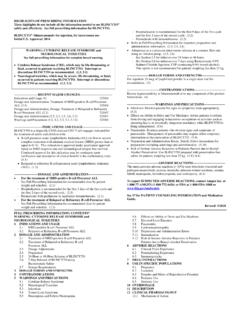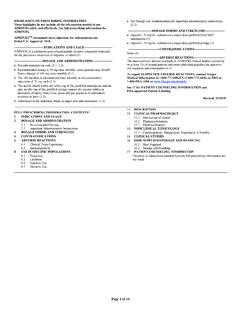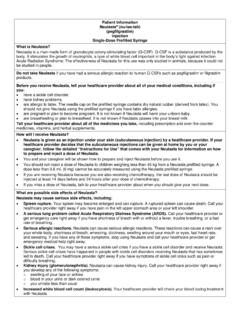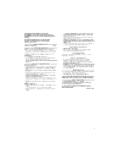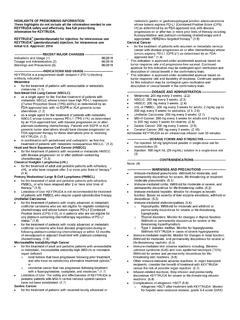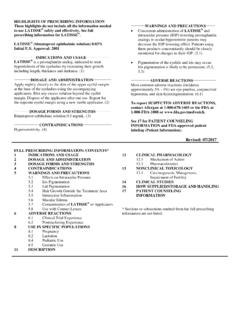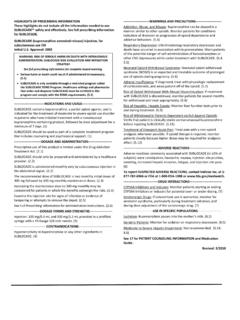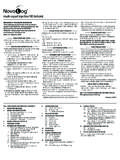Transcription of HIGHLIGHTS OF PRESCRIBING INFORMATION …
1 1 HIGHLIGHTS OF PRESCRIBING INFORMATION These HIGHLIGHTS do not include all the INFORMATION needed to use NEULASTA safely and effectively. See full PRESCRIBING INFORMATION for NEULASTA. NEULASTA (pegfilgrastim) injection, for subcutaneous use Initial Approval: 2002 ---------------------------RECENT MAJOR CHANGES--------------------------- Warnings and Precautions, Thrombocytopenia ( ) 01/2021 Warnings and Precautions, Myelodysplastic Syndrome (MDS) and Acute Myeloid Leukemia (AML) ( ) 01/2021 ----------------------------INDICATIONS AND USAGE---------------------------Neulasta is a leukocyte growth factor indicated to Decrease the incidence of infection, as manifested by febrile neutropenia, in patients with non-myeloid malignancies receiving myelosuppressive anti-cancer drugs associated with a clinically significant incidence of febrile neutropenia.
2 ( ) Increase survival in patients acutely exposed to myelosuppressive doses of radiation (Hematopoietic Subsyndrome of Acute Radiation Syndrome). ( ) Limitations of Use Neulasta is not indicated for the mobilization of peripheral blood progenitor cells for hematopoietic stem cell transplantation. ----------------------DOSAGE AND ADMINISTRATION----------------------- Patients with cancer receiving myelosuppressive chemotherapy o 6 mg administered subcutaneously once per chemotherapy cycle. ( ) o Do not administer between 14 days before and 24 hours after administration of cytotoxic chemotherapy.
3 ( ) o Use weight based dosing for pediatric patients weighing less than 45 kg; refer to Table 1. ( ) Patients acutely exposed to myelosuppressive doses of radiation o Two doses, 6 mg each, administered subcutaneously one week apart. Administer the first dose as soon as possible after suspected or confirmed exposure to myelosuppressive doses of radiation, and a second dose one week after. ( ) o Use weight based dosing for pediatric patients weighing less than 45 kg; refer to Table 1. ( ) ---------------------DOSAGE FORMS AND STRENGTHS---------------------- Injection: 6 mL solution in a single-dose prefilled syringe for manual use only.
4 (3) Injection: 6 mL solution in a single-dose prefilled syringe co-packaged with the on-body injector for Neulasta. (3) -------------------------------CONTRAIND ICATIONS ---------------------------- Patients with a history of serious allergic reactions to human granulocyte colony-stimulating factors such as pegfilgrastim or filgrastim. (4) -----------------------WARNINGS AND PRECAUTIONS------------------------ Fatal splenic rupture: Evaluate patients who report left upper abdominal or shoulder pain for an enlarged spleen or splenic rupture.
5 ( ) Acute respiratory distress syndrome (ARDS): Evaluate patients who develop fever, lung infiltrates, or respiratory distress. Discontinue Neulasta in patients with ARDS. ( ) Serious allergic reactions, including anaphylaxis: Permanently discontinue Neulasta in patients with serious allergic reactions. ( ) The on-body injector for Neulasta uses acrylic adhesive. For patients who have reactions to acrylic adhesives, use of this product may result in a significant reaction. ( ) Fatal sickle cell crises: Have occurred. ( ) Glomerulonephritis: Evaluate and consider dose-reduction or interruption of Neulasta if causality is likely.
6 ( ) Potential device failures: Instruct patients to notify their healthcare provider if they suspect the on-body injector may not have performed as intended. ( ) ------------------------------ADVERSE REACTIONS------------------------------- Most common adverse reactions ( 5% difference in incidence compared to placebo) are bone pain and pain in extremity. ( ) To report SUSPECTED ADVERSE REACTIONS, contact Amgen Inc. at 1-800-77-AMGEN (1-800-772-6436) or FDA at 1-800-FDA-1088 or See 17 for PATIENT COUNSELING INFORMATION and FDA-approved patient labeling Revised: 01/2021_____FULL PRESCRIBING INFORMATION .
7 CONTENTS* 1 INDICATIONS AND USAGE Patients with Cancer Receiving Myelosuppressive Chemotherapy Patients with Hematopoietic Subsyndrome of Acute Radiation Syndrome 2 DOSAGE AND ADMINISTRATION Patients with Cancer Receiving Myelosuppressive Chemotherapy Patients with Hematopoietic Subsyndrome of Acute Radiation Syndrome Administration Special Healthcare Provider Instructions for the On-body Injector for Neulasta Advice to Give to Patients Regarding Administration via the On-body Injector for Neulasta 3 DOSAGE FORMS AND STRENGTHS 4 CONTRAINDICATIONS 5 WARNINGS AND PRECAUTIONS Splenic Rupture Acute Respiratory Distress Syndrome Serious Allergic Reactions Allergies to Acrylics Use in Patients with Sickle Cell Disorders Glomerulonephritis Leukocytosis Thrombocytopenia Capillary Leak Syndrome Potential for Tumor Growth Stimulatory Effects on Malignant Cells Myelodysplastic Syndrome (MDS) and Acute Myeloid Leukemia (AML)
8 In Patients with Breast and Lung Cancer Potential Device Failures Aortitis Nuclear Imaging 6 ADVERSE REACTIONS Clinical Trials Experience Immunogenicity Postmarketing Experience 8 USE IN SPECIFIC POPULATIONS Pregnancy Lactation Pediatric Use Geriatric Use 10 OVERDOSAGE 11 DESCRIPTION 12 CLINICAL PHARMACOLOGY Mechanism of Action Pharmacodynamics Pharmacokinetics 13 NONCLINICAL TOXICOLOGY Carcinogenesis, Mutagenesis, Impairment of Fertility 14 CLINICAL STUDIES Patients with Cancer Receiving Myelosuppressive Chemotherapy Patients with Hematopoietic Subsyndrome of Acute Radiation Syndrome 16 HOW SUPPLIED/STORAGE AND HANDLING 17 PATIENT COUNSELING INFORMATION 2 *Sections or subsections omitted from the full PRESCRIBING INFORMATION are not listed.
9 3 FULL PRESCRIBING INFORMATION 1 INDICATIONS AND USAGE Patients with Cancer Receiving Myelosuppressive Chemotherapy Neulasta is indicated to decrease the incidence of infection, as manifested by febrile neutropenia, in patients with non-myeloid malignancies receiving myelosuppressive anti-cancer drugs associated with a clinically significant incidence of febrile neutropenia [see Clinical Studies ( )]. Limitations of Use Neulasta is not indicated for the mobilization of peripheral blood progenitor cells for hematopoietic stem cell transplantation.
10 Patients with Hematopoietic Subsyndrome of Acute Radiation Syndrome Neulasta is indicated to increase survival in patients acutely exposed to myelosuppressive doses of radiation [see Dosage and Administration ( ) and Clinical Studies ( )]. 2 DOSAGE AND ADMINISTRATION Patients with Cancer Receiving Myelosuppressive Chemotherapy The recommended dosage of Neulasta is a single subcutaneous injection of 6 mg administered once per chemotherapy cycle. For dosing in pediatric patients weighing less than 45 kg, refer to Table 1. Do not administer Neulasta between 14 days before and 24 hours after administration of cytotoxic chemotherapy.
